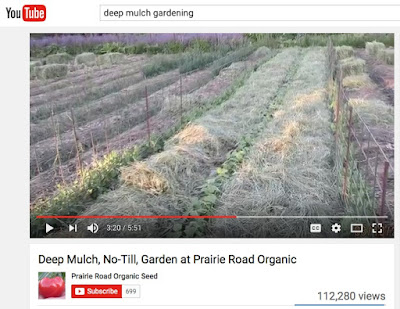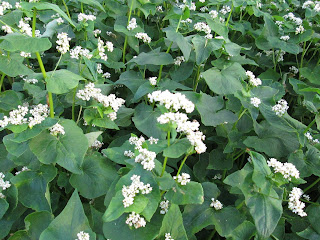Neil's Garlic
at Prairie Road Organic Seed
Got Garlic?
Garlic, the perfect choice for adding flavor to a savory recipe, is also GOOD for you! It provides a long list of health benefits due to its powerful antioxidant properties. Garlic contains a compound known as allicin, which helps lower cholesterol levels, prevent blood clotting, and has been shown to have anti-microbial and anti-cancer properties.
The best way to enjoy garlic's health benefits is to eat it raw, or close to raw. Temperatures above 140F destroy allicin. Add garlic at the very end of the cooking process, after you’ve removed the heat source, to best preserve and enjoy its flavor and health benefits.
Garlic is low in calories and high in nutrients, containing manganese, Vitamin B6, Vitamin C, selenium, and fiber. It’s a natural immune system booster that helps the body fight infection and viral attacks.
Garlic is in the Amaryllidaceae family, which includes leeks, onions, scallions, and chives. Softneck varieties (Allium sativum var. sativum) have two rings of cloves around a soft stem, which can be braided. Examples of this type are Silverskin and Artichoke garlic. Hardneck varieties (Allium sativum var. ophioscorodon), like the varieties we sell, have a single ring of cloves around a hard stem that sends up a flower stalk. Purple Striped, Porcelain, and Rocambole are of this type of garlic.
Hardneck varieties are generally a bit milder than softneck. Purple Striped, including Russian Giant and Bogatyr, store about 6 months, while Porcelain varieties, like Georgian Crystal, can store 8-10 months.
(Marbled Purple Stripe/Hardneck) 5-7 cloves per bulb. Bogatyr garlic originated in Moscow and is relatively rare. Beautiful marbled purple bulbs with easy to peel brown clove wrappers. It provides an initial spicy bite when raw but does not linger on the palate, making it ideal for recipes using raw cloves, such as pesto or hummus. Fat cloves are well-suited to roasting with a pleasing garlic flavor. Also, well-suited to fresh eating, sauteing, stir-fries, pickling, and soup. This is a consistent and productive garlic that holds well in long-term storage. This variety will grow well in most regions of the United States.
Purchasing garlic strictly for the health and culinary benefits is certainly valuable and you are very welcome to do just that! But you can greatly increase those benefits by using some of your garlic bulbs as seed... planting and growing your own garlic! Here are some tips for doing so!
Soil and Nutrient Requirements
Garlic will tolerate many soil types and textures but ideally likes rich, well-drained soils with high organic content and a soil pH of 6.5. It is difficult to grow garlic without rot problems in heavy, wet soils. Garlic likes to be well fertilized, using high-quality compost. Rotate allium crops, including onions, leeks, and garlic, at least every two years to prevent disease issues.
Planting
Garlic is best should be planted in a sunny location during the fall for a mid-summer crop the following year. It can be planted in spring, but doing so is not recommended, as it will lower yields; the garlic may not form bulbs if the cloves are not exposed to cold temperatures over winter. Garlic is usually planted October-November in the north and November-January in the south. Northern growers should plant two to four weeks before the ground freezes to ensure adequate root growth prior to winter.
To prepare separate bulbs into individual cloves right before planting, being careful not to break off the basal scar (where the clove attaches to the bulbs basal roots). Larger cloves will produce the larger bulbs. Eat the small cloves!
Plant each clove with the basal root end down and the pointed tip up, at a depth of 2” if mulching; 3-4” if not mulched. Space the cloves about 6” apart with row spacing of at least 18” or wider, if accommodating tillage equipment.
If growing in raised beds, a good general rule is to plant each clove 5-9" apart, no matter how you lay out your rows or beds. For example, plant 5” apart with row spacing of 9” or plant 9” apart with row spacing of 5”.
How much should you plant? 1-5 pounds of seed garlic will produce enough garlic for the culinary needs of most families, more if there are garlic lovers among you! The amount of garlic that your seed will produce usually ranges between 4-6 times the amount that you plant for our hardneck varieties. For example, 1 lb of garlic seed should produce an average of 5 lbs of garlic. Hardneck varieties, like ours, have an average of 4-7 cloves per bulb. Bulbs weigh about 2oz/bulb, averaging 8 bulbs/lb x 5 cloves/bulb, providing 40 seed cloves per pound of garlic.
To determine how much space your seed garlic will take up in your garden, consider this example: You have 4 pounds of seed garlic that contain 160 plantable cloves. Your garden rows are 20 ft long. If you plant your cloves 6 inches apart in a row, you will plant 40 cloves per row and will need 4 rows of space.
(Porcelain/Hardneck) 4-6 cloves per bulb. Great for salsas and pesto; just the right amount of bite, but not too spicy raw. White bulbs consist of big, easily-peeled cloves in pink and yellow wrappers. Classic roasting garlic, with a smooth buttery flavor and texture. Georgian Crystal is an extra oily garlic making it a healthy choice for its high allicin content: allicin is known to lower cholesterol and increase circulation, boosting the immune system. Well-suited to fresh eating, sauteing, stir-fries, pickling, and for inclusion in soups, pestos, hummus and any recipe calling for a clove of your favorite garlic.
Growth
Garlic grows during the cool spring season, finishing just as the summer is heating up. In the spring as the plants come up and put on their vegetative growth, water like any garden green. Nitrogen is appreciated at this stage of growth. As the days lengthen and the temperatures increase, garlic will finish growing green leaves and is ready to direct energy to its bulb.
Hardneck varieties produce flower stalks called “scapes” in early June in northern climates and as early as March or April in warm climates; these should be removed so that the plant continues to put its energy into its bulb, not the flower. Hardneck garlic sends up a flower stalk. Before the stalk begins to turn woody, starts to uncoil, and begins to stand up straight, the stalk should be cut off 1/2 inch above the top plant leaf. Clipping the scape about 1/2” above the top leaf will increase the size of the bulb and yields. Garlic scapes are often used for cooking and pesto. (See our June 23 post!)

(Marbled Purple-Stripe/Hardneck) 5-7 cloves per bulb. Large, beautiful dark purple-striped bulbs with brilliant color that catches the eye. Better than average keeping ability with brown clove wrappers; plump, easy-to-peel cloves! Initial bite mellows to a pleasant garlicky flavor. Fat cloves are well-suited to roasting with a pleasing garlic flavor. Well suited to fresh eating, sauteing, stir-frying, pickling, and in soups, pesto and hummus. A consistent and productive garlic that holds well in long-term storage. This variety will grow well in most regions of the United States, including northern climates.
Harvest
As harvest nears, plants will begin to dry down from the lowest leaf up and from the leaf tips stem-ward, a leaf at a time. Harvest when the top 4-7 leaves are still mostly green. (Earlier, if conditions are wetter to prevent water staining to the wrappers; later, if conditions are mostly dry with little risk of water stains.) Use a spade or fork to loosen the soil and lift the garlic; holding the plant stem close to the soil line, gently pull from the loosened soil, being careful not to bruise the garlic. Commercial growers or those with larger fields use an undercutting bar attachment to loosen prior to hand-digging and gathering.
Cure in a dimly lit area with ample airflow for 3-4 weeks, longer, if you live in a wet climate. Check the clove wrappers inside the bulb to make sure they are dry. After curing is complete, clip off the dried tops about ½-1inch above the bulb, trim the roots, and store in a netted onion bag or ventilated crate.
Storage
Store your garlic crop in a dark, cool part of the house, such as a basement, a seldom used closet, or a semi-heated garage. Never store garlic in a refrigerator; this will induce sprouting. Most garlic stores well at room temperature. For longer term storage 40-55 degrees is optimal. Humidity between 60%-70% is preferable to prevent dehydration of the bulbs.
Learn more!
If you find the thought of growing your own garlic intriguing, I highly recommend the book, "Growing Great Garlic," by Ron L. Engeland. Find it at your local bookstore. It is a great resource and will help ensure a successful garlic crop!
Happy Garlic Growing! Eat well, Dear Friends!
Our best to you,
Theresa, Dan & Neil





















